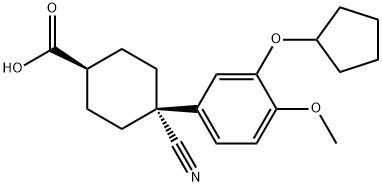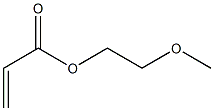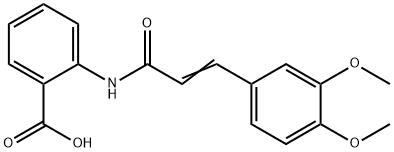Cilomilast
Synonym(s):cis-4-Cyano-4-[3-(cyclopentyloxy)-4-methoxyphenyl]cyclohexane-1-carboxylic acid;SB 207499;SB-207499
- CAS NO.:153259-65-5
- Empirical Formula: C20H25NO4
- Molecular Weight: 343.42
- MDL number: MFCD00924373
- EINECS: 200-258-5
- SAFETY DATA SHEET (SDS)
- Update Date: 2025-12-26 12:07:08

What is Cilomilast?
Chemical properties
Cilomilast is White Solid
The Uses of Cilomilast
Cilomilast is a selective phosphodiesterase 4 (PDE4) inhibitor and can be used in treatment of chronic obstructive pulmonary disease.
The Uses of Cilomilast
Selective phosphodiesterase 4 (PDE4) inhibitor. Antiasthmatic; used in treatment of chronic obstructive pulmonary disease.
Definition
ChEBI: 4-cyano-4-(3-cyclopentyloxy-4-methoxyphenyl)-1-cyclohexanecarboxylic acid is a member of methoxybenzenes.
Biological Activity
cilomilast, also known as sb-207499 or ariflo, is a potent second generation inhibitor of type 4 phosphodiesterase (pde4), an enzyme metabolizing cellular cyclic adenosine monophosphate (camp) which acts as a second messenger to disrupt the function of inflammatory cell and induce airway smooth muscle relaxation. cilomilast is currently used for the treatment of chronic obstructive pulmonary disease (copd) due to its strong anti-inflammatory activity as well as inhibitory effects against the release of neutrophil chemoattractants (such as tumor necrosis factor tnf- α, interleukin il-8 and granulocyte-macrophage colony stimulating factor gm-csf) and suppression of the recruitment of neutrophils into tissues and the ltb4 production.m profita, g chiappara, f mirabella, rcdi giorgi, l chimenti, g costanzo, l riccobono, v bellia, j bousquet, and a m vignola. effect of cilomilast (ariflo) on tnf-α, il-8, and gm-csf release by airway cells of patients with copd. thorax 2003; 58: 573-579barry d. zussman, lisa j. benincosa, dawn m webber, david j. clark, hugh cowley, john kelly, robert d. murdoch, james upward, peter wyld, andreas port and hermann fuder. an overview of the pharmacokinetics of cilomilast (ariflo), a new, orally active phosphodiesterase 4 inhibitor, in healthy young and elderly volunteers. j clin pharmacol 2001; 41: 950-958
Biochem/physiol Actions
Cilomilast (SB-207499) is a potent, selective and orally available PDE4 inhibitor that exhibits anti-inflamatory and anti-asthmatic activity.
Mechanism of action
Cilomilast contains the dialkoxyphenyl ring characteristic of selective PDE4 inhibitors. The ether oxygens hydrogen bond to a glutamine in the binding pocket, and the cyclopentyl ring adds additional hydrophobic interactions. The oxygen atoms of the carboxyl group form hydrogen bonds with water that is coordinated with Mg2+ located in the distal end of the binding pocket. Orally administered cilomilast is 96% bioavailable. Food does not interfere with the overall absorption; however, food does slow down the rate. Cilomilast is 99% bound to albumin in the plasma and is metabolized in the liver by CYP2C8. The metabolism is extensive and results in oxidation, carboxyl group glucuronidation, and dealkylation of the cyclopentyl group, followed by glucuronidation or sulfation.
Pharmacokinetics
Cilomilast is rapidly absorbed following oral administration (96% bioavailability), has an elimination half-life of 7 hours, and is extensively metabolized, but not by cytochrom P450 enzymes. The drug shows considerably more selectivity than roflumilast toward PDE4D, and this might account for the common side effects of nausea and emesis. Studies regarding the benefits of cilomilast versus placebo in the treatment of asthma have not been very encouraging, but significant improvement was seen in clinical trials of cilomilast in the treatment of COPD. The side effects of diarrhea and nausea have been considerably higher with cilomilast versus placebo, but these effects generally are tolerable and self limiting.
Properties of Cilomilast
| Melting point: | 157°C |
| Boiling point: | 549.1±50.0 °C(Predicted) |
| Density | 1.21±0.1 g/cm3(Predicted) |
| storage temp. | -20°C |
| solubility | DMSO: soluble15mg/mL, clear |
| pka | 4.45±0.25(Predicted) |
| form | powder |
| color | white to beige |
Safety information for Cilomilast
Computed Descriptors for Cilomilast
| InChIKey | CFBUZOUXXHZCFB-OYOVHJISSA-N |
New Products
4,4-Difluoropiperidine hydrochloride tert-butyl 9-methoxy-3-azaspiro[5.5]undecane-3-carboxylate Indole Methyl Resin N-Isopropylurea N,N-Dicyclohexylcarbodiimide(DCC) MELDRUMS ACID 5-METHYLISOXAZOLE-4-CARBOXYLIC ACID Magnessium Bis glycinate Zinc ascorbate 1-bromo-2-butyne 2-acetamidophenol 9(10H)-anthracenone Erythrosin B, 4-Piperidinopiperidine 2-((4-morpholinophenylamino) (methylthio) methylene) malononitrile 2,4-dihydroxybenzaldehyde 3-(4-morpholinophenylamino)-5-amino-1H-pyrazole-4-carbonitrile Methyl 2-methylquinoline-6-carboxylate 2,6-dichloro-4-nitropyridine 4-Bromo-2-chlorobenzonitrile 2-(benzylamino)acetic acid hydrochloride 4-(tert-Butoxycarbonylamino)but- 2-ynoic acid 3,4-dihydro-2H-benzo[b][1,4]dioxepine 1-Phenyl-1-cycloprppanecarboxylicacidRelated products of tetrahydrofuran








You may like
-
 Cilomilast 98% (HPLC) CAS 153259-65-5View Details
Cilomilast 98% (HPLC) CAS 153259-65-5View Details
153259-65-5 -
 Cilomilast CAS 153259-65-5View Details
Cilomilast CAS 153259-65-5View Details
153259-65-5 -
 3-(4-amino-1-oxoisoindolin-2-yl)-1-methylpiperidine-2,6-dione 98%View Details
3-(4-amino-1-oxoisoindolin-2-yl)-1-methylpiperidine-2,6-dione 98%View Details -
 614-19-7 98%View Details
614-19-7 98%View Details
614-19-7 -
 20677-73-0 (2,2-diethoxyethyl)methylamine 98%View Details
20677-73-0 (2,2-diethoxyethyl)methylamine 98%View Details
20677-73-0 -
 3-(4-(hydroxyamino)-1-oxoisoindolin-2-yl)piperidine-2,6-dione 98%View Details
3-(4-(hydroxyamino)-1-oxoisoindolin-2-yl)piperidine-2,6-dione 98%View Details -
 57381-49-4 2-bromo-4-chlorobenzonitrile 98%View Details
57381-49-4 2-bromo-4-chlorobenzonitrile 98%View Details
57381-49-4 -
 4,6-dichloropyrimidine-5-carbaldehyde 98%View Details
4,6-dichloropyrimidine-5-carbaldehyde 98%View Details
5305-40-8
